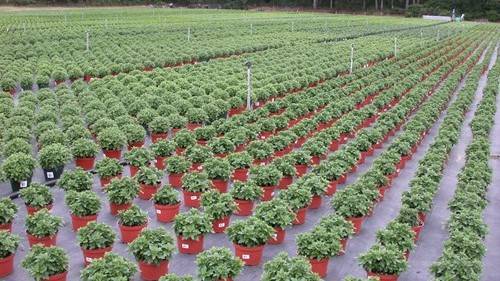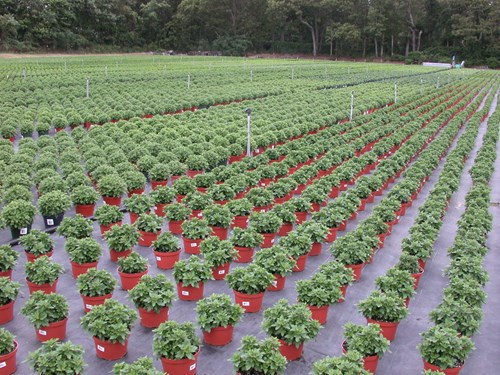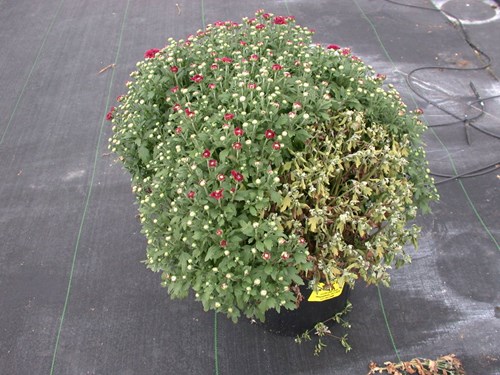Crop Tips: Chrysanthemums


Chrysanthemums (mums) may be the world’s most-grown flowers. With over 200 varieties, they come in a wide variety of floral colours. There are three primary types of chrysanthemums: pot mums, cut mums and garden mums. They are adaptable to a wide range of climatic conditions, making them suitable to grow just about anywhere. Chrysanthemums are relatively easy to take care of, whether you grow them in the greenhouse or outside.
However, there are cultural guidelines for the different varieties of chrysanthemums that need to be followed to ensure successful propagation and growth. Consult your plant supplier for detailed growing requirements of the varieties that you are planning to grow as their hardiness varies greatly depending on the cultivar. Remember that not all varieties require the same growing environment and some may be more ideal for your greenhouse environment or outdoor growing conditions than others.
Some points to consider:
Growing Medium
Chrysanthemums prefer a well-drained, well-aerated soilless medium with high water holding and cation exchange capacity. The growing medium should hold enough available water and nutrients to facilitate optimal plant growth during the heat of the summer months. Professionally produced growing media most commonly purchased for chrysanthemum production are ‘high porosity’ media, such as Premier Tech Horticulture’s PRO-MIX® HP®, PRO-MIX® BKI and/or PRO-MIX® BK.
These growing media are composed of sphagnum peat moss that will retain water and nutrients and professional-grade perlite and/or composted bark that provide drainage and aeration to help reduce potential root disease problems. Mums grow best with a starting and growing-on media pH of 5.7 – 6.2.

Watering
In mum production, it is important to maintain moderate to high growing media moisture. Allow the growing media to cycle from moist to slightly dry. Avoid both excess dry downs and long periods of wet media, especially in poor weather conditions, as this increases the potential for root disease.
To prevent water spotting or burning on sunny days, it is best to water earlier in the morning or later in the afternoon.
Fertilization/Nutrition
It is always recommended to have a comprehensive analysis of your water (alkalinity, EC, pH and potential nutrients) before beginning production. Water quality has a direct influence on the growing medium’s pH and availability of nutrients. It is recommended to choose a fertilizer that has between 60 – 75% of the total nitrogen in the nitrate form.
A fertilization program should consider some general nutritional guidelines, such as providing the correct amount of acidification or buffering to maintain proper growing medium pH, the correct nitrate-N formulation, the ideal balance of macro and micronutrients for optimal plant growth, and proper fertilizer application rate.
Most chrysanthemums are considered heavy feeders. If applying a water-soluble fertilizer, they need a constant feed of 200 - 250 ppm nitrogen. If using a controlled-release fertilizer, apply it at a conservative rate as hot weather increases the rate at which the fertilizer releases. Also use a product with a longer release as the summer heat will reduce the posted longevity of the product. Depending upon the variety, fertilization rates can be reduced when flower buds begin to show colour. The optimal media EC should be 1.5 to 2.0 mmhos/cm (2:1 extraction). Leach using clear water during production if EC is too high to prevent damage to the root system and leaves.
Potential Problems
Several pests attack chrysanthemums. Most notorious are leaf miners and thrips. Aphids, fungus gnats’ spider mites and whiteflies can also become a problem. Disease problems include Fusarium, Pythium, Rhizoctonia and leaf and flower blights. These problems can be kept to a minimum if basic cultural guidelines and practices are followed.

Controlling humidity levels, and providing adequate air movement will help minimize potential issues. Also, avoiding keeping the growing medium wet and allowing it to dry between waterings will reduce root disease problems.